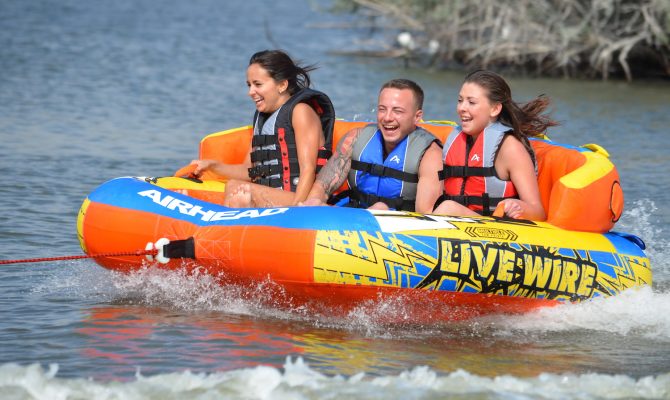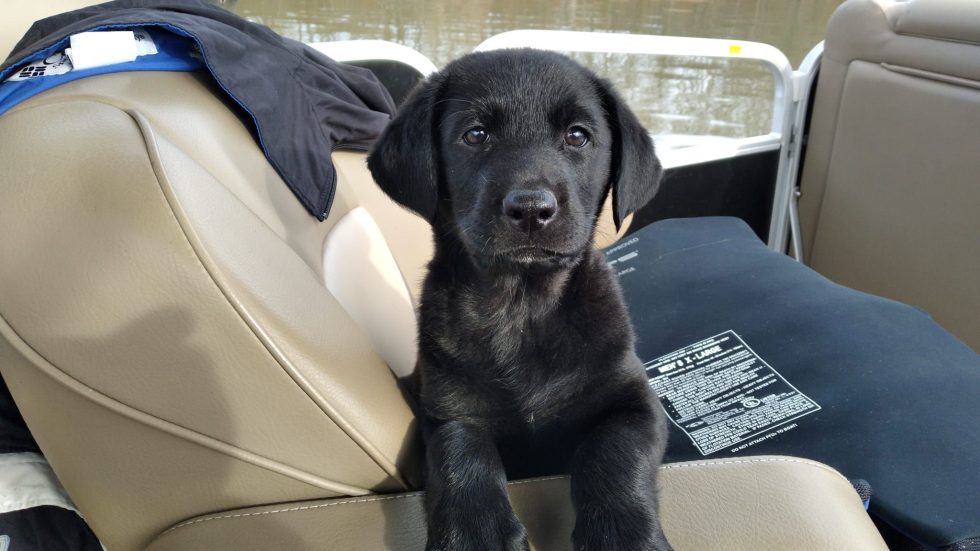Mike Pleiss of Kwik Tek, which makes the Airhead and Sportsstuff brands, claims the popularity is due to how easy and enjoyable tubes are to use, and the fact that just about any boat can be used to tow them. “Compared to waterskiing or wakeboarding, which require a certain level of skill to master, tubing is simple,” Pleiss explained. “Other than being able to swim, all that’s required of the rider is the ability to hold on.
At its most basic, a tube is an inflatable device designed to support a rider on the water’s surface while being pulled by a boat. At its most radical it’s a wearable model featuring a body made of clear PVC that, according to Pleiss “allows its occupant to see outside as he spins and barrel-rolls back and forth across the boat’s wake.”
No matter the shape or function, today’s tubes are designed to specifications of the Water Sports Industry Association (WSIA), which mandates that they must be capable of supporting 170 pounds for each “person capacity” listed and constructed with PVC air bladders covered with high strength nylon.
Pleiss categorized today’s tubes into eight styles:
Open-Top Round. The classic donut shape that you ride “sitting up with your butt in the hole, or lying down with your belly over the hole.” The Airhead Blast and Slide models are in the open-top round category.
Flat Deck. It can be round or rectangular, with no hole. Airhead Strike and Mega Slice are examples of flat deck tubes.
Cockpit. Recessed seating makes them a good choice for kids, who are held securely in position. The Airhead Viper and Mach models are examples of cockpit-style tubes.
Steerable. Fins on the bottom allow riders to shift weight and steer the tube left and right across the wake. Airhead Rip and Slash are examples, as are SportsStuff Bat X-ray and Slalom designs.
Dual Tow Point. These tubes have two or more tow points to change the riding experience, and include Sportstuff’s popular Big Mable line.
Winged. Tubes that are designed to allow the rider to stay on board while leaning into turns for support and maneuverability while under tow. Airhead’s Matrix series includes winged styles.
Hot Dog and In-Line. Permitting multiple riders to straddle the tube, they’re popular rental tubes often built to commercial quality. Airhead’s Hot Dog and Big Dog models are in-line designs.
Other. This category includes wearable tubes like the Airhead Sumo and Gyro. The Revolution spins when under way, like a carousel. The Transformer offers two interconnecting tubes — and several towing experiences — in one.
Performance & Safety
“It sounds obvious that tubes must be inflated to the pressure required to stay on top of the water, rather than dragged through the water,” said Pleiss, “but proper inflation is the most common fix when a tube isn’t performing right.”
Pleiss recommend inflating the tube until the nylon cover is tight around the PVC bladder and the tube doesn’t submerge more than an inch with the rider aboard. Immersion in cool water affects air density and can require additional inflation to maintain the proper pressure.
“On the flip side, you don’t want to store a fully inflated tube in the hot sun,” Pleiss cautioned, citing the “expanding” effects of warm air that can over-inflate and damage a tube.
The boat’s operator is responsible for overseeing the safety of passengers and riders atop towable devices, and the condition of the devices themselves. A separate observer, or “spotter,” must be posted aboard, with the responsibility of maintaining visual contact with the rider(s) at all times, each of whom must wear a properly fitted PFD.
Plenty of riders are content with being towed at idle speed, but most prefer the 15- to 20-mph pace for which the inflatables are designed.
Towing should never take place in shallow water or near shorelines, docks, pilings, swimmers, boats or other obstacles. The driver, spotter and rider should always ensure that the tow rope is clear of all body parts prior to and during use.
Where required by law (check your local regulations), a signal flag must be accessible and used by the spotter to alert others when a rider has separated from the towed device and is in the water.
That separation normally doesn’t last long, however. Following a planned or unexpected dousing, most tubers want to hop right back in the saddle to continue enjoying this exhilarating, family-friendly sport.
Author: Dan Armitage is a regular contributor to HeartLand Boating
Tube prices range from the $50 Blast single to the $900 Mega Rockstar six-person sled. A popular starter package is Airhead’s Rebel Tube, Rope & Pump Kit, which retails for $110 and includes a 54-inch diameter deck tube, 12-volt inflator and 50-foot tow rope. www.airhead.com




